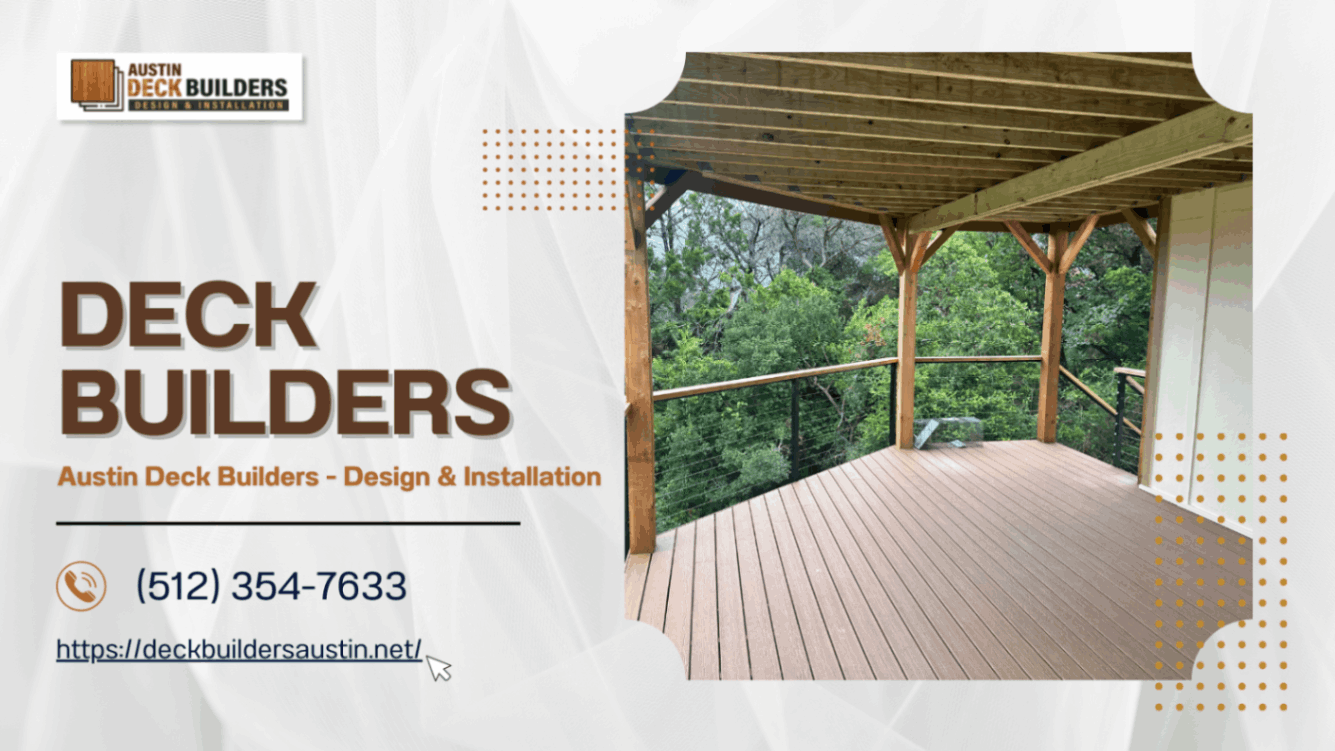

| Entity | Definition |
|---|---|
| Composite Decking | A blend of wood fibers and plastic, offering durability and low maintenance for decks. |
| Pressure-Treated Wood | Wood infused with preservatives to resist rot, insects, and decay for outdoor use. |
| Cedar Decking | A popular natural wood choice known for its beauty, resistance to insects, and weather durability. |
| Trex Decking | A well-known composite decking brand recognized for eco-friendly, long-lasting deck materials. |
| PVC Decking | Decking made from polyvinyl chloride (plastic) that’s fully resistant to moisture and rot. |
Austin Deck Builders – Outdoor Spaces Designed for Real Life
A great deck starts with great design—and Austin Deck Builders is here to make sure your outdoor space works beautifully for everyday life. From sunrise coffee spots to sunset dinners with friends, we create decks that serve as functional extensions of your home, thoughtfully built for the way you live.
Every project starts with a one-on-one consultation to get a full picture of your goals, needs, and budget. We’ll help you choose the right materials—wood or composite—and design features that bring your vision to life. Built-in benches, lighting, shade options, and multi-tiered layouts are just some of the ways we help personalize your space.
Our skilled builders work with precision and care, using best-in-class construction methods to ensure your deck stands up to time and weather. We’re proud to deliver sturdy, code-compliant decks that are as safe and solid as they are stylish.
We make the process smooth and stress-free. Clear communication, fair pricing, and dependable scheduling are all part of the Austin Deck Builders difference. We treat your home with respect and leave behind nothing but quality work and a clean space.
Let us help you create an outdoor area where you’ll love to spend time. Contact Austin Deck Builders and start designing your perfect backyard today.
Before embarking on a repair journey, it's crucial to thoroughly assess the condition of your deck railing. Look for signs of wear and tear such as loose spindles, rotting wood, or rusted metal components. Identifying all the issues at the outset will enable you to determine the extent of repairs needed and ensure that safety is restored without overlooking any potential hazards.
When repairing a deck railing, selecting appropriate materials is essential for both aesthetics and durability. For wooden railings, opt for treated lumber that can withstand the elements and resist rotting. If you're working with metal railings, choose rust-resistant options like aluminum or stainless steel. Matching materials to those originally used will also help maintain curb appeal by keeping a consistent look.
Loose railings are a common issue but they pose a significant safety risk. Tighten any loose screws or bolts to secure balusters and posts firmly in place. If parts are damaged beyond simple tightening, replace them with new hardware that matches the existing size and style for seamless integration.
In some cases, individual components of your deck railing may need replacing rather than repairing. This could include broken spindles or cracked balusters which should be matched closely with originals to maintain uniformity in design. Ensure all new pieces are installed securely to uphold safety standards.
Protective finishes can extend the life of your deck railing significantly while also enhancing its appearance. Apply stain or sealant to wooden railings every few years depending on exposure to weather conditions. For metal railings, consider using a rust inhibitor followed by paint designed specifically for exterior metal surfaces.
Regular maintenance is key to preventing future damage and ensuring ongoing safety and visual appeal of your deck railing system. Perform routine checks at least twice a year—more often if your climate subjects it to severe weather—to catch any early signs of damage before they become bigger issues.
When you decide to hire a deck builder, the first step is an initial consultation. This meeting is critical as it sets the tone for the project. You'll discuss your vision, budget, and timeline. The builder will likely ask about the size of the deck you envision, materials you're considering, and design preferences. They should also inquire about any specific functionality you desire such as built-in seating or lighting. It's during this phase that they will assess your property to determine any potential challenges or adjustments needed to accommodate a new deck.
Once your needs are clearly outlined, the deck builder will move forward with design and planning. At this stage, they might provide sketches or digital renderings of what the finished project will look like. Expect discussions around material options ranging from wood to composites based on durability, maintenance needs, and aesthetics. The builder should explain each option's advantages and drawbacks tailored to your regional climate and roofing compatibility if applicable. They'll also draft a more precise timeline and provide a detailed quote.
Before construction can begin, there’s often a need for permits depending on local regulations which can be related to zoning laws or ensuring that rooftop decks are structurally sound if tied into roof work. An experienced deck builder should handle this process for you by submitting necessary plans to local authorities for approval. They know what's required in terms of safety standards and building codes – essential factors when adding structures like decks that might impact your home's integrity.
Actual construction starts once all plans are finalized and permits obtained. Expect some disruption during this phase as workers come in and out of your property with materials and tools needed to build your deck. Timelines can vary depending on weather conditions, material availability, or unforeseen structural challenges especially if integrating with an existing roof structure; however, professional builders usually stick close to their estimated completion dates unless major obstacles occur.
Communication is key throughout the building process. Reliable builders will keep you informed of progress updates along with any issues that arise during construction – whether those involve delays due to weather or material shortages that could affect delivery times for pre-ordered items like custom railings or unique planks that match existing roofing materials seamlessly.
Upon completion of construction comes the final walkthrough where any last-minute tweaks are addressed before handing over full ownership of the new deck space back into homeowner hands – ensuring everything meets expectations set forth at project start-up meetings weeks prior; plus going over care instructions so longevity is maintained against elements year-round while discussing warranty information covering craftsmanship should future problems arise post-build period showing commitment from chosen contractor towards quality assurance long after job has finished up.

It includes site prep, permits, foundation/footings, framing, decking installation, railings, custom features, and final inspection.
Composite decks are low-maintenance, resistant to rot, insects, and fading, and offer longer lifespans than traditional wood.
A replacement includes demolition of the old deck, inspection of footings and framing, and rebuilding with updated materials and design.